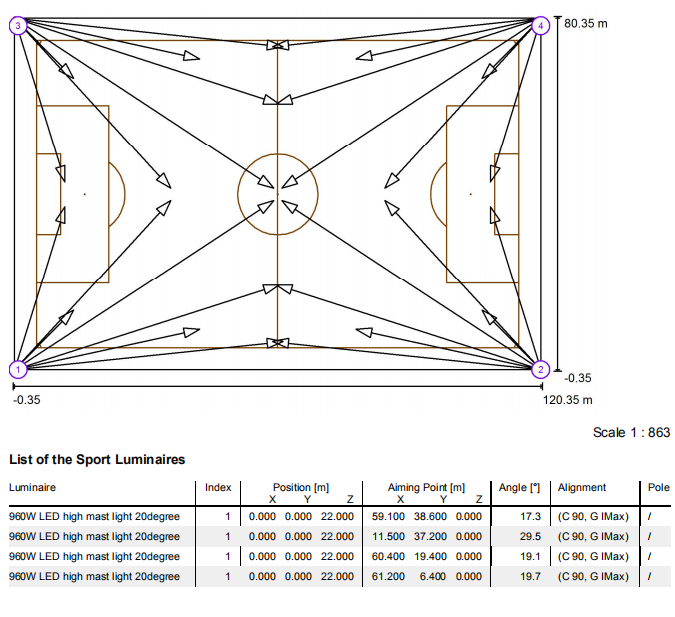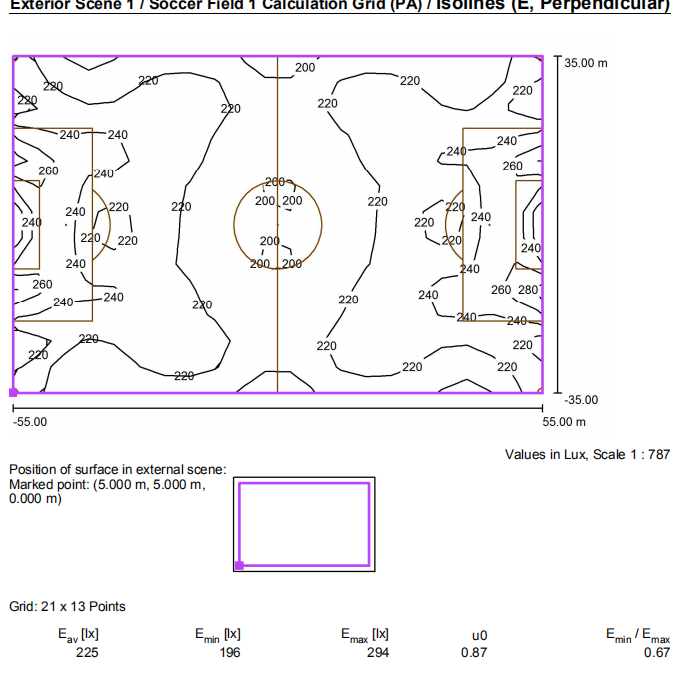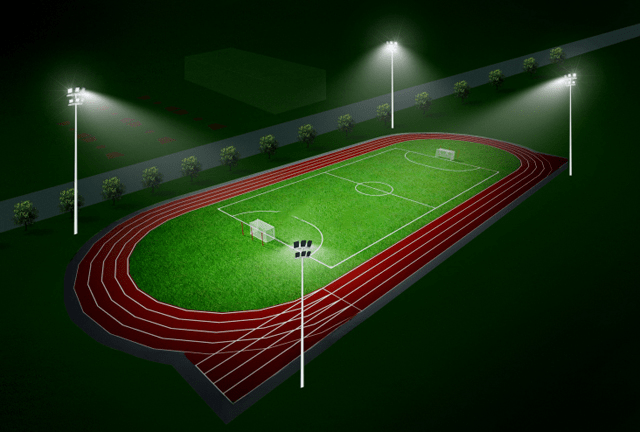Football Stadium Lighting
I. Lighting standards
Football field lighting standards
CLASS I: Minimum level for training and recreation, with 200 LUX of horizontal lighting and 0.5 uniform lighting. In the area, some high school football fields and high school sports lighting are classified.
CLASS II: Used in some leagues and clubs, about 500 lux horizontal lighting and 0.6 uniformity. Standard and Specification for Lighting of Semi-Professional Football Stadium Lighting
CLASS III: National Games, around 750lux, 0.7 uniformity. This is for professional stadiums.
II. Lighting method for Football Stadium Lighting
The lighting quality of football field mainly depends on the illuminance level, illuminance uniformity and glare control degree. The lighting level required by athletes is different from that of spectators. For athletes, the required lighting level is relatively low, and the purpose of spectators is to watch the game, and the lighting requirements increase with the increase of viewing distance. The degree of glare generated by lamps depends on the density of lamps, projection direction, quantity, viewing position in the arena, ambient brightness, etc. In fact, the number of lamps is also related to the number of seats in the stadium. Relatively speaking, training grounds only need to install normal sports lamps without high requirements; while large stadiums need to install more lamps to achieve high illumination and low glare by controlling led sports lights.
1. Installation method
There are two basic layouts for field lighting: four-corner layout - the lamps are installed on the tall tower near the diagonal extension of the stadium; lateral layout - the lamps are installed relatively low, and the lamps are located on both sides of the stadium.
The latter can be subdivided into two ways:
(1) Multi-tower (pole) installation, with 2, 3 or 4 towers on one side of the soccer field;
(2) Light strip installation. The lamps are installed on the ceiling or on the horse track. When lighting, the lights form a light strip parallel to the sideline of the court.
2. Four-corner layout
Corner tower installation method, this method is acceptable. The height of the lighthouse should ensure that the angle between the bottom row of lamps on the tower and the center of the court is not less than 20°. In order to reduce the glare to athletes and spectators, this angle can be relaxed to 30°, but the investment in the lighthouse will be reduced. increases, and the ratio of vertical illuminance to horizontal illuminance decreases. At least 5° outward from the midpoint of the sideline to ensure vertical illumination on players near the sideline. By increasing this angle, glare is reduced and vertical illuminance is simultaneously increased for athletes moving toward the baseline. The limit for increasing the angle is determined by the canopy of the stand that obstructs the lighting of the lamps and the shadows on the pitch. The midpoint of the goal should be at least 15° outwards to limit glare to players in the goal area during corner kicks.
Two angular limit lines define the position of the lighthouse, ideally as close to the diagonal extension of the pitch as possible. In order to ensure that the entire stadium is illuminated, the angle between the bottom row of lights of the lighthouse and the pitch and the pitch is not greater than 70°, which can effectively determine the minimum distance from the lighthouse to the corner of the pitch.
3. Lateral lighting
The recommended position for lateral lighting, the requirements of floodlights are suitable for both multiple towers (2, 3, and 4 towers on one side) and light strips.
Viewed from the direction of the vertical axis of the stadium, the minimum value of α of 20° is only suitable for training fields and low-level stadiums, because the glare control level is low at this time. When α is 25°, the glare is well controlled and the vertical illuminance is high. Although increasing α is beneficial for controlling glare, the vertical illuminance component is reduced, and the investment in lighthouses or horse walks will be greatly increased. It is not possible to increase the ceiling of the grandstand in order to increase the α angle, although the structure can withstand flood lighting installations.
The elevation angle of the floodlight near the edge is determined by the angle β. If there is a proper ratio between the horizontal illuminance and the vertical illuminance, the β angle should not be greater than 75°. If the lamps on the edge of the ceiling of the stand do not have a suitable beta value, the floodlights can be installed under the ceiling or other special methods can be adopted.
There are 3 or 4 floodlights on each side of the court. When the β value is between 75° and 60°, it is necessary to use 4 towers on each side to ensure proper illumination uniformity. When the β value is between 60° and 45°, the arrangement of 3 towers on each side should be considered. As the β value approaches 45°, the lighthouse height that satisfies the α recommendation becomes similar to the four-corner arrangement. In fact, 2 towers per side can also be used successfully.
The floodlights are arranged approximately continuously. Light strips extend beyond the bottom line of the court to maintain illumination at both ends of the court. In places where it is difficult to install lamps, the floodlights at the ends are as close to the middle as possible.
4. Glare control on sports lighting
Luminaire mounting height and floodlight location affect glare control, as discussed earlier. However, there are other related factors that affect glare control.
The number of floodlights for each project is determined by the illuminance in the site. With the four-corner arrangement, the number of lighthouses is less than that of side-mounted lights, so less light enters the field of vision of athletes or spectators. On the other hand, the number of floodlights used for four-corner lighting is more than that of lateral lighting. From any point of the stadium, the sum of the light intensity of each lighthouse floodlight of four-corner lighting is more than that of lateral lighting. The light intensity of the belt mode is larger. Experiments have shown that it is difficult to choose between the two lighting arrangements. Often, the choice of lighting layout and the exact location of the lighthouse are more a function of cost or site conditions than lighting factors.
It is not recommended to associate glare with illuminance, because other factors being equal, as the illuminance increases, the adaptation level of the human eye also increases, and in fact, the sensitivity to glare is not affected.
5. Flood light’s intensity distribution
Regardless of the four-corner lighting or the lateral lighting, the floodlights must use narrow-beam lamps to illuminate the arena area farthest from the lights. The angle between 1/10 of the maximum light intensity of the beam and the maximum light intensity is not It should be greater than 12°. Excessive spill light beyond this range can also cause glare.
6. The projection direction of the LED sports lamps
Floodlights must aim accurately and maintain their design position throughout their life. For athletes, goalkeepers are the most vulnerable. As for glare, for spectators, the front of the public area on the side of the stadium and the back of the goal have the worst viewing conditions. When designing the projection direction of the floodlights, these positions are used to evaluate the quality of glare control.
III. Installation, operation and maintenance
1. Installation and operation
When the adjustable floodlight has been installed, the projection position of the lamp should be marked so that the lamp can be easily restored to its original position if the lamp is to be maintained or repaired in the future. For other sports on the field, such as throwing and track events, it is recommended not to change the aiming point of the original floodlight. Experience has shown that accurate re-setting of the aiming point will waste time and increase investment. It is recommended to set up two independent lighting systems, each of which can be controlled according to its own needs.
The lighthouse and its foundation shall comply with relevant local laws and regulations, and persons without authoritative approval shall not engage in such work. Be sure to maintain lighting fixtures without danger.
2. Maintenance
Lighting devices should be cleaned regularly. If the light bulbs, lamps or ballasts stop working or their functions are significantly reduced, the LEDs need to be tested for light decay and should be replaced separately to ensure that the illuminance meets the relevant regulations. The advantages of cleaning and replacing bulbs (LED lamps) in batches are obvious, which can reduce the labor cost of replacing bulbs and reduce the chance of bulb damage during the service period. Based on local conditions, determine the minimum, acceptable average illuminance value for the playing field, which is the basis for developing maintenance regulations.
IV. Sports lights for soccer field
Outdoor football field at the TV broadcasting level are recommended to use high power outdoor LED floodlights /Stadium lights. The LED sports lamps we manufacture, are compact and beautiful in appearance, small in wind resistance and light in weight. Uniquely designed light distribution curve; precise beam, multiple light distribution, instant start;
Bisaprk recommends the use of high-efficiency flood light stadium LED lamps. We uses unique light-emitting lens to effectively and uniformly project light onto the surface of the object, avoiding light loss, and greatly improving the light utilization rate and the brightness of the object surface. The product performance and luminous efficiency are higher than similar products, and the light projection effect is the best.
V, football field lighting design and effect



